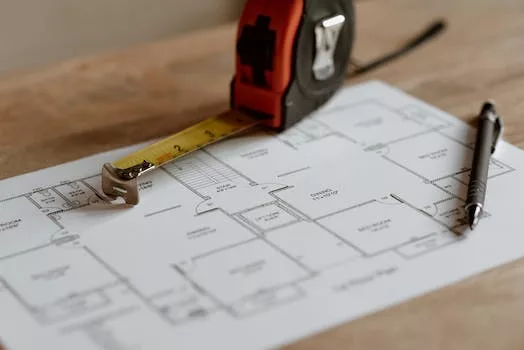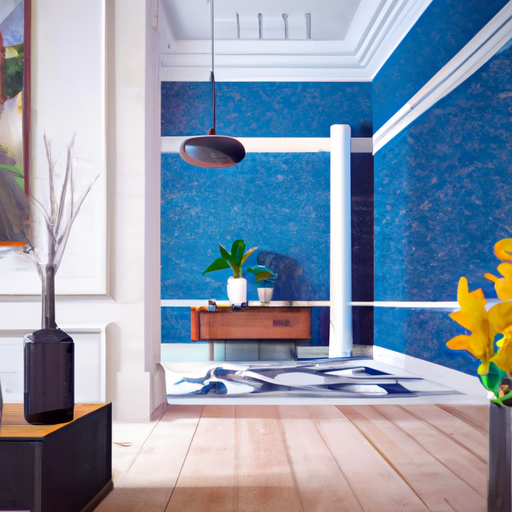Exploring Bold Geometric Shapes for a Striking Interior Design
The world of interior design is constantly evolving, with new trends and styles emerging every year. One of the most exciting and innovative design concepts that has gained popularity in recent years is the use of bold geometric shapes to create architectural drama in your home. This design approach can transform a space from ordinary to extraordinary, making a powerful statement and leaving a lasting impression on all who enter. In this article, we will explore the various ways in which you can incorporate geometric shapes into your interior design, creating a striking and visually captivating living space.
The first step in creating architectural drama in your home is to understand the power of geometry. Geometric shapes have been used in architecture and design for centuries, with their clean lines and sharp angles providing a sense of order and balance. By incorporating these shapes into your interior design, you can create a sense of harmony and unity within your space, while also adding a touch of modern sophistication.
One of the most effective ways to introduce geometric shapes into your home is through the use of statement furniture pieces. Look for items with bold, angular lines and unique shapes that will stand out and draw the eye. For example, a sculptural coffee table with a geometric base can serve as a stunning focal point in your living room, while a set of angular dining chairs can add visual interest to your dining area. Don’t be afraid to mix and match different shapes and styles, as this can create a dynamic and visually engaging space.
Another way to incorporate geometric shapes into your interior design is through the use of bold patterns and prints. This can be achieved through the use of wallpaper, textiles, or even artwork. Look for patterns that feature strong geometric shapes, such as chevrons, hexagons, or triangles. These can be used to create a striking accent wall, or to add a touch of drama to your soft furnishings, such as cushions, curtains, or rugs. When selecting your patterns, consider the scale of the shapes and how they will work within your space. Larger shapes can make a bold statement, while smaller, more intricate patterns can add subtle interest and texture.
Lighting is another crucial element in creating architectural drama in your home, and geometric shapes can play a significant role in this. Look for light fixtures with strong geometric lines, such as pendant lights with angular shades or floor lamps with sculptural bases. These can not only provide a functional source of light but also serve as eye-catching design features within your space.
In addition to furniture, patterns, and lighting, you can also incorporate geometric shapes into your home through the use of architectural features. This can include elements such as built-in shelving, room dividers, or even staircases. By incorporating geometric shapes into the very structure of your home, you can create a truly unique and dramatic living space.
Finally, when incorporating geometric shapes into your interior design, it’s important to consider the overall balance and harmony of your space. While bold shapes and patterns can create a striking effect, it’s essential to ensure that they don’t overwhelm the room. Be mindful of the scale and proportion of your geometric elements, and consider how they will work alongside your existing furniture and décor. By carefully considering these factors, you can create a visually captivating and architecturally dramatic home that is both stylish and functional.
In conclusion, the use of bold geometric shapes in interior design can create a striking and visually engaging living space. By incorporating these shapes through statement furniture pieces, bold patterns, lighting, and architectural features, you can transform your home into a modern and sophisticated haven. With careful consideration of scale, proportion, and balance, you can create a truly unique and dramatic living space that will leave a lasting impression on all who enter.
Integrating Statement Lighting to Enhance Architectural Features

Lighting is an essential element in any interior design scheme, and when used effectively, it can transform the atmosphere of a room and create a sense of architectural drama. Statement lighting, in particular, can be used to enhance the architectural features of your home, drawing attention to unique details and creating a focal point that elevates the overall design. In this article, we will explore various ways to integrate statement lighting into your home to create a sense of architectural drama.
One of the most effective ways to use statement lighting to enhance architectural features is by using it to highlight specific elements within a space. For example, if you have a beautiful fireplace or an intricate ceiling design, you can use a statement chandelier or pendant light to draw the eye upwards and emphasize these features. Similarly, if you have a stunning staircase or a unique wall texture, you can use wall sconces or floor lamps to create a dramatic effect that showcases these elements.
Another way to create architectural drama with statement lighting is by using it to define different areas within an open-plan space. In a large living area, for example, you can use a statement chandelier above the dining table to create a sense of intimacy and separation from the rest of the room. This not only adds visual interest to the space but also helps to establish a clear hierarchy of functions within the room, making it feel more organized and cohesive.
In addition to highlighting specific architectural features, statement lighting can also be used to create a sense of depth and dimension within a room. By using a combination of ambient, task, and accent lighting, you can create a layered lighting scheme that adds depth and interest to the space. For example, you can use a statement chandelier as the main source of ambient light, while also incorporating floor lamps and table lamps for task lighting and wall sconces for accent lighting. This will create a dynamic and visually engaging environment that showcases the architectural features of your home.
When selecting statement lighting for your home, it’s important to consider the scale and proportion of the fixtures in relation to the space. A statement chandelier or pendant light should be large enough to command attention but not so large that it overwhelms the room. Similarly, wall sconces and floor lamps should be appropriately sized for the space and the architectural features they are intended to highlight. By carefully considering the scale and proportion of your statement lighting, you can ensure that it enhances the architectural features of your home without overpowering the space.
Finally, it’s important to consider the style and material of your statement lighting in relation to the overall design of your home. While it’s perfectly acceptable to mix and match different styles and materials, it’s important to ensure that your statement lighting complements the existing design elements in your home. For example, if your home features a lot of natural materials and organic shapes, you might choose a statement chandelier made from wood or a pendant light with a woven shade. Alternatively, if your home has a more minimalist aesthetic, you might opt for a sleek metal chandelier or a geometric pendant light.
In conclusion, integrating statement lighting into your home is an effective way to create architectural drama and enhance the unique features of your space. By carefully considering the placement, scale, and style of your statement lighting, you can create a visually engaging environment that showcases the architectural features of your home and elevates the overall design. Whether you’re highlighting a stunning fireplace, defining different areas within an open-plan space, or creating a sense of depth and dimension, statement lighting is a powerful tool that can transform the atmosphere of your home.
Utilizing Textures and Materials for a Visually Dynamic Living Space
Creating architectural drama in your home is an art that requires a keen eye for detail and a deep understanding of the various elements that contribute to a visually dynamic living space. One of the most effective ways to achieve this is by utilizing textures and materials in a manner that not only complements the overall design of your home but also adds depth and character to the space. In this article, we will explore some of the ways in which you can use textures and materials to create a visually stunning and dramatic living space.
To begin with, it is important to understand that textures and materials play a crucial role in defining the overall look and feel of a space. They can either make a room feel cozy and inviting or cold and sterile, depending on the choices you make. Therefore, it is essential to carefully consider the type of textures and materials you want to incorporate into your home, keeping in mind the desired ambiance and the architectural style of the space.
One of the most effective ways to create architectural drama in your home is by using contrasting textures and materials. This can be achieved by juxtaposing rough and smooth surfaces, or by combining materials with different visual weights, such as heavy stone and lightweight glass. For instance, a living room with a sleek, polished concrete floor can be beautifully contrasted with a plush, textured area rug. Similarly, a modern glass staircase can be paired with a rough, exposed brick wall to create a striking visual impact.
Another way to create visual interest in your home is by using materials with unique patterns and textures. For example, incorporating a statement wall made of reclaimed wood or an intricately patterned tile can instantly add character and depth to a space. Additionally, using materials with natural variations, such as marble or granite, can create a sense of movement and flow in a room, adding to the overall architectural drama.
Incorporating metallic accents is another effective way to add drama and sophistication to your living space. Metals such as brass, copper, and gold can be used in various forms, including light fixtures, furniture, and decorative accessories. These metallic elements not only add a touch of glamour and luxury to the space but also help to reflect light, creating a visually dynamic environment.
When it comes to textiles, choosing fabrics with rich textures and patterns can also contribute to the architectural drama of your home. Velvet, for example, is a luxurious fabric that can add depth and warmth to a space, while bold, geometric patterns can create a sense of energy and movement. Layering different textures and patterns through the use of throw pillows, curtains, and upholstery can further enhance the visual interest of a room.
Lastly, it is important to remember that lighting plays a crucial role in highlighting the textures and materials used in your home. By strategically placing light sources, you can accentuate the various textures and materials, creating a visually dynamic and dramatic living space. For instance, using wall sconces to cast light on a textured wall can create interesting shadows and depth, while pendant lights can draw attention to unique architectural features or materials.
In conclusion, creating architectural drama in your home is all about making thoughtful choices when it comes to textures and materials. By incorporating contrasting surfaces, unique patterns, metallic accents, and rich textiles, you can create a visually dynamic living space that is both captivating and inviting. Furthermore, by paying attention to lighting and the strategic placement of light sources, you can further enhance the visual impact of the textures and materials used in your home, resulting in a truly dramatic and unforgettable living environment.
Q&A
Question 1: How can I create architectural drama in my home using lighting?
Answer: To create architectural drama using lighting, consider incorporating layered lighting with a mix of ambient, task, and accent lights. Use dimmers to control the intensity, and choose fixtures that complement your home’s design. Highlight architectural features like vaulted ceilings, exposed beams, or textured walls with uplighting or downlighting.
Question 2: What materials can be used to add architectural drama to a home?
Answer: Materials that can add architectural drama to a home include exposed brick, reclaimed wood, concrete, metal accents, and large expanses of glass. These materials can be used for walls, floors, ceilings, or as accent pieces to create visual interest and contrast.
Question 3: How can I use color to create architectural drama in my home?
Answer: To use color for architectural drama, choose bold and contrasting colors that make a statement. You can create an accent wall with a vibrant hue, use color blocking to define different areas, or incorporate colorful furniture and accessories. Additionally, consider using different finishes like matte, glossy, or metallic to add depth and texture.
Conclusion
In conclusion, creating architectural drama in your home involves incorporating bold design elements, playing with scale and proportion, using contrasting materials and textures, and integrating unique lighting solutions. By thoughtfully combining these elements, homeowners can transform their living spaces into visually striking and emotionally engaging environments that reflect their personal style and taste.


